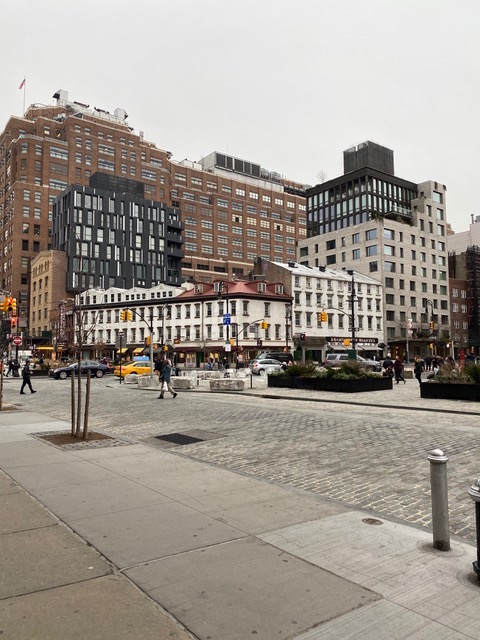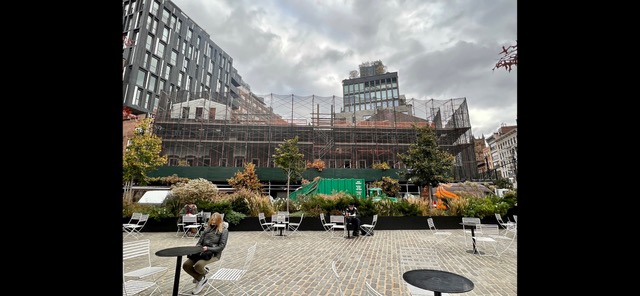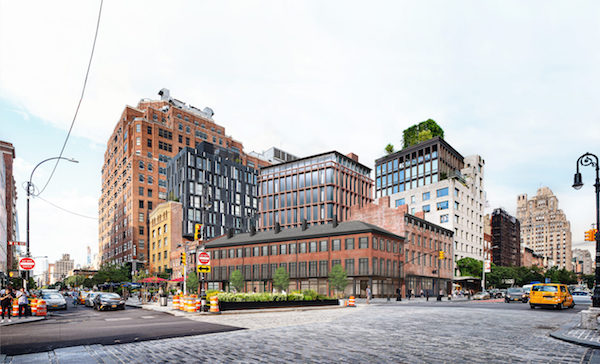
BY PAMELA WOLFF (President, Save Chelsea)| Chelsea, and New York, are again the losers in the game played by city agencies—supposedly champions of public interest—and the self-interested real estate industry. This time we lost a large chunk of our history.
It is a gut punch of a public spectacle—the demolition of all nine landmarked rowhouse façades at Ninth Avenue and West 14th Street. Developer Tavros acquired them in 2014 and last year received approval from the Landmarks Preservation Commission (LPC) to build an office tower in their historic rear yards. Tavros’ promise to meticulously restore the street façades of the 1840s houses couldn’t have hurt the glaringly inappropriate tower’s odds of approval.
According to LPC’s Gansevoort Market Historic District Designation Report, the six rowhouses on Ninth Avenue “form a picturesque ensemble at the wide, angled intersection of West 14th and Hudson Streets and Ninth Avenue” and “are rare surviving examples of 1840s pitched-roofed rowhouses in Manhattan.” The intersection, now called Chelsea Plaza, has become one of Manhattan’s glossiest public spaces and a gateway to the thriving Meatpacking District, adding to the prominence of the rowhouses. What a pity that only a replica of their façades will be on view, like a stage set for passing tourists.
Tavros claims to have discovered the façades were at risk of collapse only after receiving its LPC permit. It then notified the Department of Buildings (DOB), which ordered their demolition. The developer is obligated to reconstruct the building fronts from as many original bricks as can be salvaged, but the rowhouses will have lost the authenticity that makes landmarks worth saving.
It is hard to believe that all nine façades—built as part two separate projects in the 1840s—were all somehow deteriorated beyond rescue. It is clear that with the historic buildings out of the way, access to the block interior to construct the tower will be a much easier, faster, and cheaper job. In a city so rich in restoration expertise, we are expected to believe no means could be found to repair them.
A November 12th meeting with DOB failed to dispel doubts. The DOB was represented by Commissioner Melanie La Rocca and Chief Engineer for Enforcement Tim Lynch. For a meeting heavily attended by the full panoply of elected officials, community groups, and preservation activists, the absence of either LPC’s Chair Sarah Carroll or Executive Director Lisa Kersavage stood out. Even if they knew the meeting would merely let DOB check its community-engagement box, their presence and endorsement of DOB’s decision would have been reassuring. LPC was represented only by its Deputy Counsel, John Weiss, who had little to say. Repeatedly pressed on any expert opinion LPC had sought separately from Tavros’ engineer or DOB—something Save Chelsea had requested—Weiss was evasive and never directly replied. La Rocca at one point interrupted this questioning as if to spare him.
Doubts about LPC’s position are also raised by a joint letter from LPC and DOB responding to concerns raised by Village Preservation. It read, in part:
As it relates to who authorized the demolition, under the Landmarks Law section 25-312, DOB’s assessment that the façades must be immediately taken down in the interest of public safety understandably preempt LPC’s review and approval authority. Nonetheless, DOB and LPC have been working closely together on this situation, which thankfully is an unusual occurrence.

Whatever “working closely” may imply, it conspicuously falls short of saying LPC agrees with DOB. We can only hope this apparently unilateral DOB demolition order is an “unusual occurrence,” but nothing DOB had to say at the meeting inspired confidence that the same judgement might not be passed on other landmarks for the same reasons. Quite the contrary. Tim Lynch cited perfectly characteristic features of older rowhouses in making his case that the Gansevoort rowhouses were beyond salvage. These included wood window heads and nailing strips set into the inside faces of the brick façades, and—in the case of the six three-story rowhouses on Ninth Avenue—façades that are eight inches thick. (Lynch said they were from the 1820s, contradicting the 1845-46 construction date cited in LPC’s Gansevoort Market Historic District Designation Report.) Lynch also stressed that the rowhouses suffered from the kinds of deterioration common to their age and building type, but had no comment when established remedies for these familiar problems were suggested, like stitching together delaminated brick wythes with stainless steel helical tiles or regrouting loosened bricks.
It was impossible to say whether the handful of images presented in the meeting were typical, or cherry-picked, worst-case examples. One photo of collapsing floor joists seemed chosen for dramatic impact, but was irrelevant, as the floor joists were always scheduled for removal, and in any case were not structurally supporting the façades. Perhaps inadvertently, this photo captured a large expanse of the façade’s interior brick surface, which appeared in quite good condition.
It again strains credulity that proven restoration methods could not have been safely applied to the façades now that they had been stabilized with steel shoring. It is a truism that any repair can be made at a cost. Asked what alternatives to disassembly had been explored and why they’d been rejected, DOB had no answer. Asked specifically why the rowhouse façades couldn’t be pinned back to the party walls from which they had in places separated, Lynch replied, “I didn’t think it was an option”—even though a restoration product is made for this purpose. If Lynch had explained his reasoning, it might have been reassuring. Instead, we’re left to wonder whether nine landmarks are falling to an individual’s opinion. Worse yet, Lynch seemed to be arguing that historic buildings can age out of the possibility of restoration—this in a city of relatively young landmarks compared to centuries-older European buildings that preservationists manage to save (Notre Dame, for example).

Will landmark owners now seek to circumvent landmark protection by submitting their buildings to Lynch’s preemptive judgement? Façadism has been the bane of historic districts in recent years. Developers now routinely get LPC approval to replace rowhouses with larger new buildings behind preserved street fronts. It would be much easier for them to construct those new buildings without having the front wall in the way and in need of temporary shoring. If they can get away with removing street façades and replacing them with replicas, the only thing left of our architectural heritage will be some recycled bricks.
While landmark owners are required to maintain their buildings, there is little downside for failure to do so. In the meeting, Betty Mackintosh, co-chair of Community Board 4’s Chelsea Land Use Committee, asked what penalty applies—the answer: A fine of $2,500.
The optics of this tragedy are terrible for DOB and LPC. Both agencies have let us down. The precedent it sets is potentially devastating for New York. We must take this loss as a battle cry to demand a structural change in the way our brick-and-mortar heritage is protected.
Chelsea Community News is made possible with the help of our awesome advertisers, and the support of our readers. If you like what you see, please consider taking part in our GoFundMe campaign (click here). To make a direct donation, give feedback, or send a Letter to the Editor, email scott@chelseacommunitynews.com.

Pingback: This Week in Chelsea: January 17-23, 2022 – Chelsea Community News